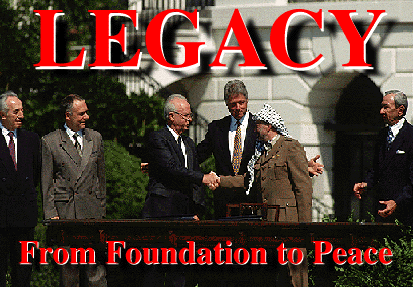
| The Camp David experience has had two important legacies. One follows on with the story of the Middle-East and that is the story of reduced conflict on the path to peace. The other has to do with how Camp David contributed to understanding the processes of conflict and of bargaining between states. | Legacy Exhibit:
President Carter's View
Path to Peace
About Negotiating
References
|
|---|
President Carter's own view: 
Path to Peace
Signing the Camp David Accords initiated rather than concluded a path to peace. A long series of decisions connects the Accords with the current developments in the Middle East. This section describes the major signposts along the way.
Egyptian-Israeli Peace Treaty
While the Accords created a framework for a negotiated peace treaty, the two parties stilled had to actually agree on some of the more problematic elements in order to creating a final peace between Egypt and Israel. On 27 September 1978, less than two weeks from concluding the Accords, the Israeli Knesset voted to approve the Camp David Accords and to withdraw the Israeli settlements in the occupied Sinai.
The negotiators met in Washington and debated the three major problems:
- the timetable for Israeli withdrawal from the Sinai
- the exchange of ambassadors
- the future of the West Bank/Gaza territories
The American position continued to be that the two parties had so much to gain that they overshadowed what they had to lose on these other issues. But the momentum of Camp David was quickly dissipated in the conflicting positions of the two parties. Within a very short time, the negotiations between the two states ground to a halt. By December, President Carter was pessimistic about ultimate agreement.
In late February, the administration reviewed the situation, looking for new avenues of agreement between the two. The President decided to make one last attempt at a treaty and invited the two leaders to visit Washington, one at a time, in early March, 1979. Initially, negotiations between Carter and Begin did not go well. Eventually though, Begin agreed to submit a US text to the Cabinet and it voted to accept. Carter prepared for a trip to the Middle East in order to complete a text of a treaty.
Carter's discussions with the two parties in the Middle East eventually arrived at a peace treaty. It was signed on 26 March 1979.
A New Framework for Peace
Understanding Negotiations
The Camp David experience illustrates a number of important lessons about international negotiations:
- Precursors: The most difficult step is obtaining agreement when to initiate negotiations and who was to be involved.
- All sides must be convinced of three things:
- that they have a mutual problem.
- that they can resolve it together.
- that each party will negotiate in good faith.
- In dealing with sovereign states the US must always avoid the attitude of a "litigant." Sovereign states cannot be made to enforce treaties and negotiated settlements. They must want to abide by the agreement.
- Perspectives: It is especially important to "understand the unique perspectives of those with whom we would be contending."
- Framework: It is desirable to create a framework within which negotiators can believe that agreement is possible and which will allow adversaries to withdraw positions whenever agreement is necessary without losing face. It ought to:
- include the key issues under contention.
- be sufficiently general so as to allow for maximum flexibility.
- Incentives to Negotiate: Once negotiations have begun, it is very useful to remind the parties and to be reminded what is at stake in successful agreement and what is at risk from failure. All negotiations begin with the reality that both parties have a substantial investment in successfully negotiating an agreement.
- Review: Constantly reviewing the situation during the negotiations maximizes the opportunity for new ideas.
- Deadlines: Concluding an agreement is often helped by setting some kind of deadline.
Some Related Resources
You can obtain a list of the reference works on the Middle East used to help prepare this exhibit. Try the Patch High simulation of Mid-East Conflict. Or for some basic information, try the Government of Israel's Information gopher. Lastly, contact the WWW search center [Lycos] at Carnegie-Mellon University to obtain information on any subject covered on the WorldWide Web.